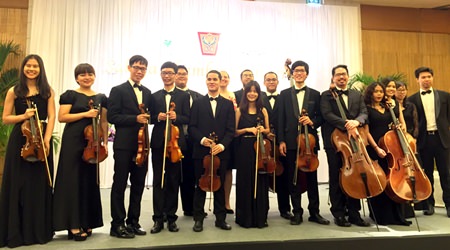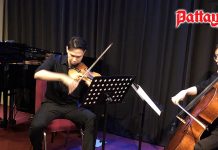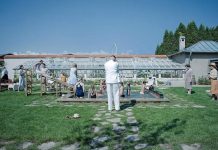An enthusiastic audience welcomed the Salaya Chamber Orchestra at a recent concert in Pattaya’s Centara Grand Mirage Beach Resort on July 12. Presented by Pattaya International Ladies Club in support of several local charities, the concert included a delightful selection of classical works.
The Salaya Chamber Orchestra, founded in 2011 is a training orchestra made up of talented students from the College of Music at Mahidol University. All the musicians are from the pre-college and undergraduate programmes and they also play in smaller groups such as string quartets or piano trios. Coached by cellist Stefanie Waegner, the orchestra members are expected to rehearse and perform entirely by themselves, taking the full musical responsibility for their performances.
 Salaya Chamber Orchestra. (Photo/Jakob Friis)
Salaya Chamber Orchestra. (Photo/Jakob Friis)
This was a splendid concert which captivated the audience and lifted the spirits and was made possible with support from Centara Grand Mirage Resort and Rotary Club Jomtien Pattaya. The dry acoustics of the heavily carpeted recital hall added a special challenge because with virtually no reverberation, every nuance of the playing is revealed. The players seemed to gain confidence as the evening progressed.
The concert kicked off with a lively and compelling performance of Bach’s Concerto in D minor for Two Violins and Strings featuring soloists Chanya Charoensook and Teesin Puriwatthanapong. They gave a good account of this technically demanding work and the lyrical second movement was played with a fine awareness of melody and phrasing. The cello and double bass continuo provided reliable support throughout the concerto.
Haydn’s String Quartet Op 76 No 4 in the 1790’s is known as the Sunrise because of the rising theme over sustained chords that begin the work. It was given an attractive performance by Varissara Tanakom and Pattapol Jirasuttisarn (violins), Krit Supabpanich (viola) and Kantika Comenaphatt (cello). The dynamics were beautifully judged, the phrasing effective and it seemed to me that quite a bit of thought had gone into the preparation. The ethereal slow movement was especially well performed with careful control of dynamics and the minuet splendidly articulated. This quartet has some tricky technical moments but these talented players performed with confidence, the breathless final section of the last movement bringing their performance to a triumphant conclusion.
Mendelssohn was only twelve or thirteen when he composed his four-movement Sinfonia No. 7 in D minor. This work featured the full chamber orchestra of six violins, two violas, three cellos and double bass. The symphony is a remarkable work considering the age of the composer and was one of the highlights of the evening. The orchestra gave a rhythmic and engaging performance of the delicately-scored first movement and they achieved a telling contrast between the main themes. The slow second movement was an absolute delight with some elegant string playing with fine controlled tone. The young composer’s use of harmony in this movement is remarkably sophisticated and his extraordinary sense of invention came through in the minuet too, which was played with excellent articulation and a lively sense of rhythm. The musicians gave a confident account of the sizzling last movement which seemed to hint at Mendelssohn’s mature style.
Another highlight of the concert was Carl Nielsen’s delightful Suite for Strings. The orchestra was really on form for this challenging work, and gave a lovely performance of the lilting waltz that forms part of the second movement. Their playing of the colourful and sometimes tempestuous last movement was thrilling.
The encore piece was Leroy Anderson’s 1951 jolly composition for pizzicato strings entitled Plink, Plank, Plunk! which the orchestra seemed to enjoy as much as the appreciative audience.




